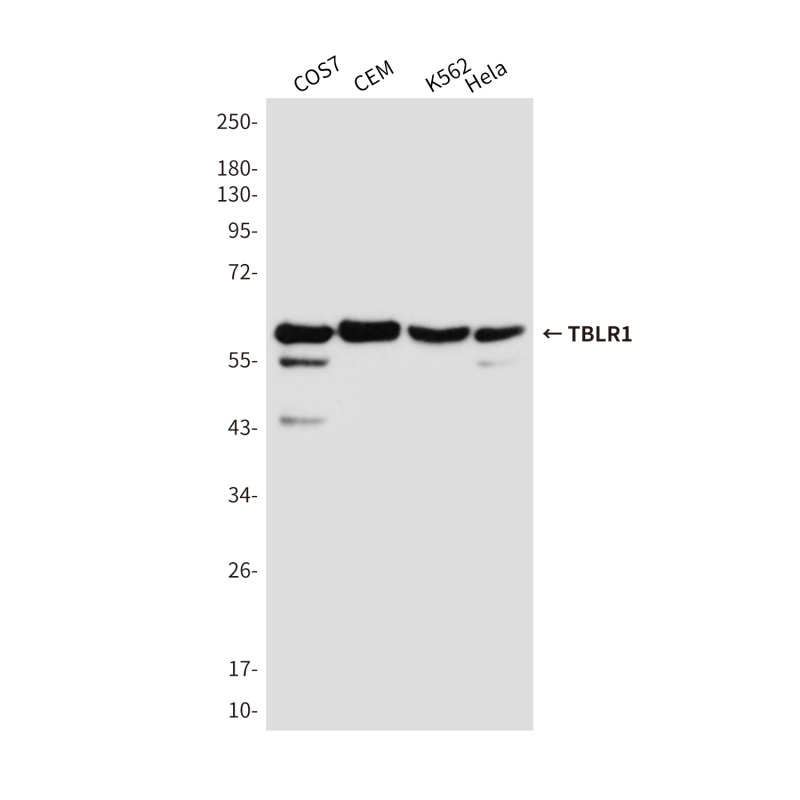
| WB | 咨询技术 | Human,Monkey |
| IF | 咨询技术 | Human,Monkey |
| IHC | 1/50-1/100 | Human,Monkey |
| ICC | 1/50-1/200 | Human,Monkey |
| FCM | 咨询技术 | Human,Monkey |
| Elisa | 咨询技术 | Human,Monkey |
| Aliases | C21; DC42; F box like/WD repeat containing protein TBL1XR1; F-box-like/WD repeat-containing protein TBL1XR1; FLJ12894; IRA1; Nuclear receptor corepressor/HDAC3 complex subunit; Nuclear receptor corepressor/HDAC3 complex subunit TBLR1; TBL1 related protein 1; TBL1-related protein 1; TBL1R_HUMAN; TBL1XR1; Transducin (beta) like 1 X linked receptor 1; Transducin beta like 1X related protein 1; Transducin beta-like 1X-related protein 1. |
| Entrez GeneID | 79718 |
| WB Predicted band size | Calculated MW: 56 kDa; Observed MW: 60 kDa |
| Host/Isotype | Mouse IgG1 |
| Antibody Type | Primary antibody |
| Storage | Store at 4°C short term. Aliquot and store at -20°C long term. Avoid freeze/thaw cycles. |
| Species Reactivity | Human,Monkey |
| Immunogen | A synthesized peptide derived from Human TBL1XR1 |
| Formulation | Purified antibody in PBS with 0.05% sodium azide,0.5%BSA and 50% glycerol. |
+ +
以下是3篇关于TBLR1抗体的参考文献,包含文献名称、作者和摘要概述:
---
1. **"TBLR1 is a novel prognostic marker and promotes epithelial-mesenchymal transition in colorectal cancer"**
*Authors: Li Y, et al. (2019)*
**摘要**:研究利用TBLR1抗体进行免疫组化和Western blot分析,发现TBLR1在结直肠癌中高表达且与患者预后不良相关,机制上通过激活Wnt/β-catenin信号通路促进肿瘤转移。
2. **"TBLR1 functions as a coactivator in steroid receptor-mediated transcription through its interaction with the NCoA/SRC family"**
*Authors: Zhang C, et al. (2016)*
**摘要**:通过免疫共沉淀(Co-IP)和染色质免疫沉淀(ChIP)实验,使用TBLR1抗体证实其与核受体共激活因子(NCoA/SRC)的相互作用,揭示TBLR1在激素依赖性基因调控中的关键作用。
3. **"The role of TBLR1 in macrophage polarization and inflammation"**
*Authors: Wang H, et al. (2020)*
**摘要**:研究采用TBLR1抗体进行流式细胞术和免疫荧光染色,发现TBLR1通过调控NF-κB信号通路驱动巨噬细胞向促炎表型极化,参与动脉粥样硬化的发展。
---
以上文献均明确使用TBLR1抗体进行蛋白定位、相互作用或功能验证,涉及癌症、转录调控及免疫炎症等领域。如需具体DOI或期刊信息可进一步补充。
TBLR1 (Transducin Beta-Like 1X-related protein 1), also known as GPS2-interacting protein, is a nuclear receptor coregulator involved in transcriptional regulation and chromatin remodeling. It functions as a scaffold component of the N-CoR/SMRT (Nuclear Receptor Corepressor/Silencing Mediator of Retinoic Acid and Thyroid Hormone Receptor) corepressor complex, which recruits histone deacetylases (HDACs) to repress gene expression. TBLR1 plays a critical role in mediating ligand-dependent turnover of nuclear receptor-corepressor complexes, facilitating the exchange between corepressors and coactivators during transcriptional activation.
Structurally, TBLR1 contains an N-terminal LisH dimerization motif and a C-terminal WD40 repeat domain, enabling interactions with HDAC3. GPS2. and nuclear receptors. It is implicated in diverse biological processes, including cell differentiation, metabolism, and inflammation, by modulating Wnt/β-catenin, NF-κB, and nuclear receptor signaling pathways. Dysregulation of TBLR1 has been linked to cancers (e.g., breast, prostate), metabolic disorders, and neurodegenerative diseases.
TBLR1 antibodies are essential tools for studying its role in transcriptional repression/activation mechanisms. They are widely used in applications like Western blotting, immunoprecipitation (IP), chromatin immunoprecipitation (ChIP), and immunofluorescence (IF) to investigate protein expression, localization, and interactions. These antibodies are typically raised against specific epitopes (e.g., N-terminal or C-terminal regions) in hosts like rabbits or mice, with validation across species (human, mouse, rat). Their specificity and reliability make them crucial for elucidating TBLR1's functional dynamics in health and disease.
×